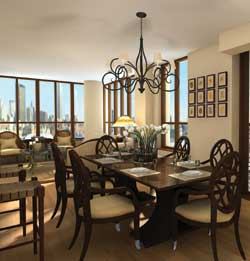Supreme Decision
Ruling protects firms’ traditional legal rights. Apartment owners with multi-state portfolios dodged a bullet in November when the U.S. Supreme Court reaffirmed apartment companies’ right to be sued in federal court, rather than state courts in areas which they operate.
The case, Lincoln Property v. Roche, started as a simple mold suit, but soon became a case revolving around jurisdictional issues after a ruling by the Fourth Circuit of the U.S. Court of Appeals. That federal court, which covers Virginia and three other states, ruled that the Lincoln trial should instead be happening in state court because the Lincoln affiliate in question was operating in Virginia.
This represented a big change from the past, when apartment firms who were sued in a state other than the one in which they were headquartered could get the trial moved to federal court under what is known as diversity jurisdiction. The federal appeals court’s ruling threatened that arrangement. “The whole purpose of diversity jurisdiction is that you can’t give the plaintiff home court advantage,” says Stephen Renna, senior vice president and counsel for the Real Estate Roundtable, a Washington, D.C.-based organization serving all real estate sectors.
If the U.S. Supreme Court had backed the Fourth Circuit, multifamily firms operating outside of their home state might have needed to change how they establish individual business entities. “It’s a very important legal victory for the multifamily housing industry and the rest of the commercial real estate sector,” says Howard Menell, tax advisor for the National Multi Housing Council.
–Les Shaver
Big Buyers
Toll Brothers condo-converts a Virginia apartment complex. Big home builders are boldly entering a new territory: condo conversions. Public builder Toll Brothers recently condo-converted an apartment complex in Leesburg, Va., purchased from Archstone-Smith’s Ameriton subsidiary.
The property, Stratford Club, marks Toll’s first conversion in the Mid-Atlantic region, says Scott Melnick, co-director of the institutional multifamily group for Transwestern Commercial Services, which brokered the $65 million deal. (Toll executives were unavailable for comment, despite repeated phone calls.)
Other home builders are quickly following suit, and for good reason, says Melnick. “Home builders need inventory and land takes more and more time to get zoned,” he says. “When they buy a piece of land they never can predict exactly when it will be fully entitled and built, so the condo conversion scenario allows builders to get current income, or at least more predictable timing.”
For Toll, the condo conversion of Stratford Club was a fairly easy transition from their usual business strategy of building new because the property was sold mid-construction, says Greg Gieber, an analyst for A.G. Edwards. (Ameriton had built the property, originally called Westchester at Stratford Farm, with the intent to quickly sell to a condo converter). “They are deviating from the model of being a builder to just one of a sales agent,” Gieber says. The project didn’t require any interior upgrades.
–Rachel Z. Azoff
Executive Feedback
How do you plan to stay competitive with the growing condo rental market?
A: “Apartment living means exceptional service, sophisticated amenities, and the flexibility to live an on-the-go lifestyle. KSI partners with companies like American Express and VIPdesk concierge to provide residents with ongoing services and convenience they cannot find elsewhere.” –Karen A. Kossow, assistant vice president of sales and marketing, KSI Management
A: “BH has always focused on amenities and services for our properties. We will try to convert potential condo buyers into renters by offering them custom upgrades in their apartments. They will be able to select light fixtures, cabinet hardware, and window coverings to their decorating styles. It will provide them with a feeling of ownership in their apartment home. We want people to feel at home with upgrades and accessories like they see offered at Pottery Barn or The Home Depot.” –Laurie Lyons, CEO, BH Management
A: “Condo investors are not operators [who] have a deep understanding of the needs of a resident, and therefore their customer service will most likely be lacking. The apartment industry also has a greater understanding of where and how to market for renters than the condo market does.” –A. David Lynd, COO, The Lynd Co.
Project of the Month: Oleson Woods Apartments
Portland, Oregon Oleson Woods Apartments seems to be paying homage to Mother Nature. The 32-unit affordable housing neighborhood, located in Portland, Ore., reflects the delicate fusion between residential development and natural preservation, thanks to sensitive land planning and architectural design.
Carleton Hart Architecture designed Oleson Woods to harmonize with the site’s natural landscape and wildlife habitat. More than a dozen mature tree canopies, some more than 2 feet in diameter, were preserved throughout the 3.1-acre site. The property’s exterior design, featuring steep gables and a Northwest cottage style, also flows well with the environment.
But preserving the site’s lush surroundings proved to be the designer’s biggest challenge. The parcel seemed untouchable, mostly because of its thick strand of trees and seasonal wetland. Brian Carleton, a principal at the architecture firm, didn’t want to strip the property’s natural beauty, so the firm found a way to build around it and play up the site’s natural resources.
Carleton’s strategy was to go for less density to save the trees and wetlands. “We were focused on a sustainable design,” Carleton says. “We wanted to be sensitive to the environment.” Density is about 10 units per acre.
The architect also designed Oleson Woods to be energy-efficient. The project’s green building elements include whole-house ventilation systems, on-site rainwater filtration, natural lighting, Energy Star appliances, and cement fiberboard siding.
Community Partners for Affordable Housing developed and manages the project. So far, two-thirds of the units are already leased. Monthly rents range from $328 to more than $700 for one- to four-bedroom units.
–Abby Garcia Telleria
